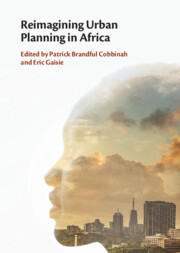Book contents
- Reimagining Urban Planning in Africa
- Reimagining Urban Planning in Africa
- Copyright page
- Contents
- Contributors
- Foreword
- Preface
- Acknowledgements
- Abbreviations
- Part I Understanding Sustainable Urban Planning in Africa
- Part II Case Studies on Urban Planning in African Countries
- 7 The Proliferation of Gated Communities
- 8 History, Practices, Challenges and Opportunities of Urban Planning in Zimbabwe
- 9 The Evolution and Nature of Urban Planning in Nigeria
- 10 Rethinking Urban Planning and Informal Settlement Upgrading
- 11 Urban Planning Challenges and Slum/Informal Housing Formation in Ogun State, Nigeria
- 12 The Proliferation of Slums in Cameroon
- 13 An Overview of Urban Planning in Tanzania
- Part III Sustainable Urban Planning in Africa
- Index
- References
7 - The Proliferation of Gated Communities
Towards Reimagining Urban Planning in Ghana
from Part II - Case Studies on Urban Planning in African Countries
Published online by Cambridge University Press: 07 December 2023
- Reimagining Urban Planning in Africa
- Reimagining Urban Planning in Africa
- Copyright page
- Contents
- Contributors
- Foreword
- Preface
- Acknowledgements
- Abbreviations
- Part I Understanding Sustainable Urban Planning in Africa
- Part II Case Studies on Urban Planning in African Countries
- 7 The Proliferation of Gated Communities
- 8 History, Practices, Challenges and Opportunities of Urban Planning in Zimbabwe
- 9 The Evolution and Nature of Urban Planning in Nigeria
- 10 Rethinking Urban Planning and Informal Settlement Upgrading
- 11 Urban Planning Challenges and Slum/Informal Housing Formation in Ogun State, Nigeria
- 12 The Proliferation of Slums in Cameroon
- 13 An Overview of Urban Planning in Tanzania
- Part III Sustainable Urban Planning in Africa
- Index
- References
Summary
Planning systems are instrumental in the emergence and proliferation of gated communities globally. This chapter presents evidence of how Ghana’s planning system has contributed towards the emergence and proliferation of gated communities as a basis for reimagining urban planning. The study employs institutional analysis and uses data from interviews with planning officials in 7 district assemblies and 11 gated community developers in the Accra City Region. Unlike the colonial planning law which had little regard for local exigencies, Ghana’s current planning system now recognises gated communities and the emerging indigenous typologies. It also allows gated community developers to prepare local plans for areas lacking one. By recognising gated communities and allowing them planning functions, district assemblies save on the cost of preparing planning schemes, while also benefiting from significant increases in property rates, and easing the mobilisation of those rates. While applying formal rules to deliver their mandate, officials also draw on informal rules that appear to privilege developers of gated communities, creating avenues for dubious practices to thrive. The study concludes by positing that urban planning in Ghana, and indeed across Africa, can be reimagined by focusing on the strengths, weaknesses, opportunities and threats of planning systems.
- Type
- Chapter
- Information
- Reimagining Urban Planning in Africa , pp. 109 - 130Publisher: Cambridge University PressPrint publication year: 2023



